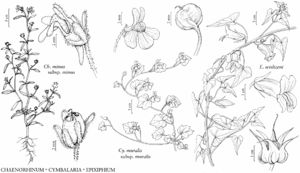Difference between revisions of "Chaenorhinum minus subsp. minus"
FNA>Volume Importer |
imported>Volume Importer |
||
| (6 intermediate revisions by 2 users not shown) | |||
| Line 1: | Line 1: | ||
{{Treatment/ID | {{Treatment/ID | ||
|accepted_name=Chaenorhinum minus subsp. minus | |accepted_name=Chaenorhinum minus subsp. minus | ||
| − | |accepted_authority= | + | |accepted_authority= |
|publications= | |publications= | ||
|special_status={{Treatment/ID/Special_status | |special_status={{Treatment/ID/Special_status | ||
| Line 11: | Line 11: | ||
}}{{Treatment/ID/Special_status | }}{{Treatment/ID/Special_status | ||
|code=F | |code=F | ||
| − | |label= | + | |label=Illustrated |
}} | }} | ||
|basionyms= | |basionyms= | ||
| Line 29: | Line 29: | ||
|elevation=0–1600 m. | |elevation=0–1600 m. | ||
|distribution=Alta.;B.C.;Man.;N.B.;Nfld. and Labr. (Nfld.);N.W.T.;N.S.;Ont.;P.E.I.;Que.;Sask.;Ala.;Ark.;Colo.;Conn.;Del.;Ga.;Idaho;Ill.;Ind.;Iowa;Kans.;Ky.;La.;Maine;Md.;Mass.;Mich.;Minn.;Mo.;Mont.;Nebr.;N.H.;N.J.;N.Y.;N.C.;N.Dak.;Ohio;Okla.;Oreg.;Pa.;R.I.;Tenn.;Tex.;Vt.;Va.;Wash.;W.Va.;Wis.;Europe;sw Asia;introduced also in e Asia (Russian Far East). | |distribution=Alta.;B.C.;Man.;N.B.;Nfld. and Labr. (Nfld.);N.W.T.;N.S.;Ont.;P.E.I.;Que.;Sask.;Ala.;Ark.;Colo.;Conn.;Del.;Ga.;Idaho;Ill.;Ind.;Iowa;Kans.;Ky.;La.;Maine;Md.;Mass.;Mich.;Minn.;Mo.;Mont.;Nebr.;N.H.;N.J.;N.Y.;N.C.;N.Dak.;Ohio;Okla.;Oreg.;Pa.;R.I.;Tenn.;Tex.;Vt.;Va.;Wash.;W.Va.;Wis.;Europe;sw Asia;introduced also in e Asia (Russian Far East). | ||
| − | |discussion=<p>Subspecies minus is the only member of Chaenorhinum minus to have become widely established as a weed; the other three subspecies occur in Europe, one each in Corsica, Crete, and Turkey.</p><!-- | + | |introduced=true |
| − | --><p>First collected in Camden, New Jersey (1874), and St. John, New Brunswick (1881), Chaenorhinum minus likely came to North America as a contaminant in ship ballast, with subsequent dispersal along railroad lines (M. P. Widrlechner 1983). R. M. Arnold (1981, 1982) noted that self-compatibility, a short generation time, drought tolerance, and seed dispersal enhanced by passing trains allowed C. minus to be a successful colonizer of railroad rights-of-way, where it was once common but is now scarce because of herbicide use.</p> | + | |discussion=<p>Subspecies minus is the only member of <i>Chaenorhinum minus</i> to have become widely established as a weed; the other three subspecies occur in Europe, one each in Corsica, Crete, and Turkey.</p><!-- |
| + | --><p>First collected in Camden, New Jersey (1874), and St. John, New Brunswick (1881), <i>Chaenorhinum minus</i> likely came to North America as a contaminant in ship ballast, with subsequent dispersal along railroad lines (M. P. Widrlechner 1983). R. M. Arnold (1981, 1982) noted that self-compatibility, a short generation time, drought tolerance, and seed dispersal enhanced by passing trains allowed <i>C. minus</i> to be a successful colonizer of railroad rights-of-way, where it was once common but is now scarce because of herbicide use.</p> | ||
|tables= | |tables= | ||
|references= | |references= | ||
| Line 39: | Line 40: | ||
-->{{#Taxon: | -->{{#Taxon: | ||
name=Chaenorhinum minus subsp. minus | name=Chaenorhinum minus subsp. minus | ||
| − | + | |authority= | |
| − | |authority= | ||
|rank=subspecies | |rank=subspecies | ||
|parent rank=species | |parent rank=species | ||
| Line 54: | Line 54: | ||
|publication title= | |publication title= | ||
|publication year= | |publication year= | ||
| − | |special status=Weedy;Introduced; | + | |special status=Weedy;Introduced;Illustrated |
| − | |source xml=https:// | + | |source xml=https://bitbucket.org/aafc-mbb/fna-data-curation/src/2e0870ddd59836b60bcf96646a41e87ea5a5943a/coarse_grained_fna_xml/V17/V17_87.xml |
|genus=Chaenorhinum | |genus=Chaenorhinum | ||
|species=Chaenorhinum minus | |species=Chaenorhinum minus | ||
Latest revision as of 19:37, 5 November 2020
Stems much-branched from or near base, sometimes unbranched, often zig-zag, (4–)8–28(–40) cm. Leaves: blade 5–15(–30) × 1–4(–5) mm, base tapered, apex obtuse to acute, surfaces glandular-pubescent. Pedicels ascending. Flowers: calyx lobes accrescent, abaxial 1.5–2.5 × 0.3–0.4 mm, adaxial 2.8–3.5 × 0.4–0.8 mm, margins entire, apex obtuse; corolla 8–11 mm (including 1–2.3 mm spur), sparsely glandular-pubescent externally, glandular-pubescent internally on abaxial surface, especially along ridges of palate and into throat, throat 2–3 mm diam., abaxial lobes spreading, adaxial projecting; stamens included, anthers opposite, navicular, marginally coherent, pollen sacs of longer pair of stamens 0.3–0.4 mm, of shorter pair of stamens 0.1–0.2 mm, glabrous; ovary glandular-pubescent; style 1.5–2 mm, glandular-pubescent proximally. Capsules obovoid to ellipsoid, 4–5.4 × 2–3.6 mm, glandular-pubescent distally. Seeds 0.6–0.9 mm, prominently ribbed longitudinally. 2n = 14, 28 (both Europe).
Phenology: Flowering May–Oct.
Habitat: Gravelly railroad rights-of-way, road shoulders, urban areas, stream beds.
Elevation: 0–1600 m.
Distribution
Introduced; Alta., B.C., Man., N.B., Nfld. and Labr. (Nfld.), N.W.T., N.S., Ont., P.E.I., Que., Sask., Ala., Ark., Colo., Conn., Del., Ga., Idaho, Ill., Ind., Iowa, Kans., Ky., La., Maine, Md., Mass., Mich., Minn., Mo., Mont., Nebr., N.H., N.J., N.Y., N.C., N.Dak., Ohio, Okla., Oreg., Pa., R.I., Tenn., Tex., Vt., Va., Wash., W.Va., Wis., Europe, sw Asia, introduced also in e Asia (Russian Far East).
Discussion
Subspecies minus is the only member of Chaenorhinum minus to have become widely established as a weed; the other three subspecies occur in Europe, one each in Corsica, Crete, and Turkey.
First collected in Camden, New Jersey (1874), and St. John, New Brunswick (1881), Chaenorhinum minus likely came to North America as a contaminant in ship ballast, with subsequent dispersal along railroad lines (M. P. Widrlechner 1983). R. M. Arnold (1981, 1982) noted that self-compatibility, a short generation time, drought tolerance, and seed dispersal enhanced by passing trains allowed C. minus to be a successful colonizer of railroad rights-of-way, where it was once common but is now scarce because of herbicide use.
Selected References
None.
